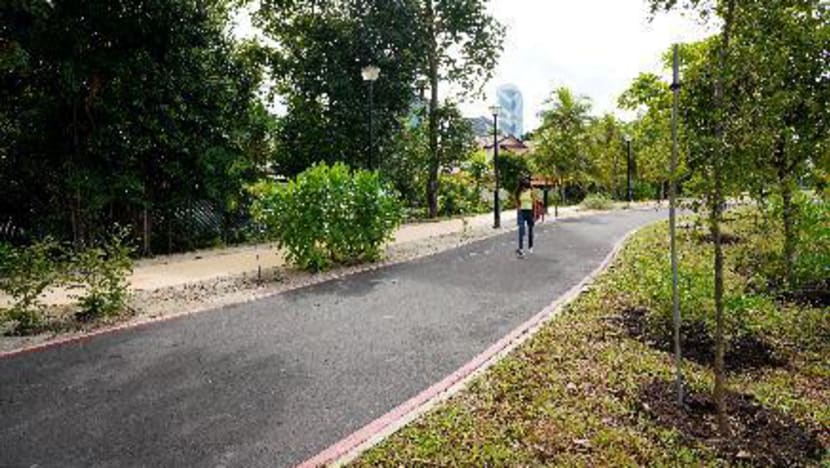NParks opens first section of Pasir Panjang Park as part of 'extensive green network' in West Coast
- The 450m section of Pasir Panjang Park runs from Pasir Panjang MRT station to the Jalan Pelepah residential estate
- NParks will establish more than 10 nature ways and rewild up to 14 sites in the west by 2030
- MRT stations along the Jurong Regional Line will be greened over the next 10 years
- Thirty community and allotment gardens will be added across the heartlands in the West Coast area
SINGAPORE: A section of Pasir Panjang Park opened on Saturday (Sep 4) as part of an “extensive green network” to be built in Singapore’s west, said National Development Minister Desmond Lee.
The 450m stretch, which is the first section of the park, runs from Pasir Panjang MRT station to the Jalan Pelepah residential estate.
The entire park, which is expected to be completed by 2026, will showcase the "natural and cultural history" of Pasir Panjang, said Mr Lee.
This is the first park to be designed and built together with the community, under the Friends of the Parks Engagement Programme, said the National Parks Boards (NParks) in a separate media release.
About 170 stakeholders were involved, including residents engaged through the Telok Blangah Residents’ Committees and the Pasir Panjang East Association Neighbourhood Committee.


According to Mr Lee, the first section of the park used to be part of a “natural sandy beach” running from Batu Berlayer to the junction of Clementi and West Coast Roads.
It later became Pasir Panjang Wharves and then the Pasir Panjang Container Terminal.
“Special care has been taken to landscape the park to reflect the area’s formerly sandy coastline, and to restore the coastal vegetation that once permeated the area,” said the minister.
“The park will also pay tribute to Pasir Panjang’s history as home to one of Singapore’s major ports, the Pasir Panjang Container Terminal."
The Government previously announced that the container terminal would move to Tuas as part of its plans to transform the Greater Southern Waterfront.
To commemorate the history of the park, horn bollards used at the Tanjong Pagar Terminal since 1972, along with other maritime artefacts, will be displayed in the park.
The next phase of the park’s development will include heritage boards and a heritage gallery featuring old photos of the area contributed by the community.
NParks will also work with the community to plant more trees in the park, design more wayfinding and interpretation signage and demarcate user information on footpaths and cycling paths.
MORE NATURE WAYS AND REWILDING SITES
At the opening, Mr Lee announced plans to further green the West Coast area by 2030.
Plans for the West Coast Green Corridor include enhanced ecological connectivity between the west and the rest of Singapore, greening infrastructure and industrial areas, and more gardens and gardening spaces.
More than 10 "nature ways" will be established in the west, by "enhancing our streetscapes with multi-tiered lush naturalistic plantings”, said the minister.
Nature ways are routes with specific plants to facilitate the movement of birds and butterflies.
“In line with the character of the West Coast area, native coastal species will be used in these plantings," said Mr Lee.
These nature ways will strengthen ecological connectivity by forming a “green corridor” connecting north towards Sungei Buloh and east towards Labrador via the West Coast, said NParks.
In addition, NParks will rewild up to 14 sites near existing nature areas, such as the Southern Ridges and Rail Corridor, said Mr Lee.
This will be done with native trees and plants to “enhance habitats for local biodiversity”.

Related:
GREENING INFRASTRUCTURE AND INDUSTRIAL ESTATES
MRT stations along the upcoming Jurong Region Line will be "greened up" in three stages over the next 10 years, said Mr Lee.
Currently, Buona Vista, Dover and Boon Lay stations along the East-West Line have already undergone such greening.
NParks will also plant 150,000 trees in Jurong industrial estates by 2030, as part of previously announced plans to plant 170,000 trees in industrial estates.
“The aim is to cool these areas, one of the hotter areas in Singapore and improve air quality," said NParks.
"At the same time, this will create a more attractive and conducive work environment by bringing the therapeutic effects of greenery close to people’s workplaces."
Sensors will also be deployed at Jurong Estate and Jurong Island to measure thermal comfort to help NPark assess the effectiveness of greenery in mitigating the urban heat island effect in those areas.
MORE GARDENS, GARDENING SPACES
Up to 30 more community and allotment gardens will be added across the heartlands in the West Coast area, said Mr Lee.
This is in addition to the existing 120 such gardens across housing estates, schools and organisations in the West Coast.
Two new therapeutic gardens will also be introduced in Jurong Central Park and West Coast Park.
These gardens will let visitors "experience a range of health benefits, such as relief from mental fatigue, reduced stress and an overall improvement to well-being”, said NParks.
Nature playgardens that include components for children with special needs are in the works as well, allowing them to experience nature-based therapy, it added.
In all, almost 40 new nature-based amenities will be added to the West Coast area by 2030.
NParks added that it will be involving residents in the conceptualisation and development of these new green spaces, and it will organise community tree-planting activities under the OneMillionTrees movement.
The OneMillionTrees movement is the Government’s plan to plant one million trees by 2030.














